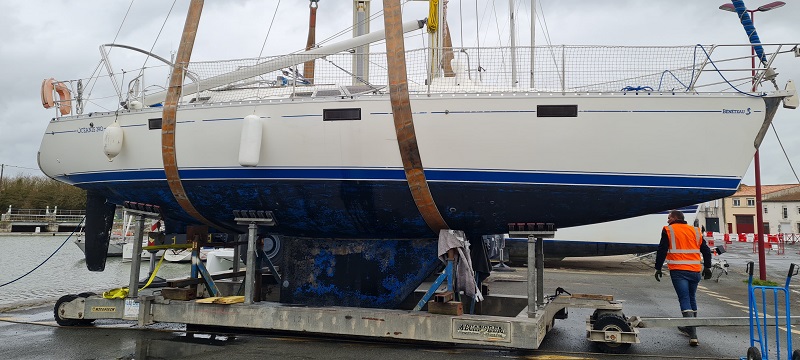Review of Oceanis 390

Basic specs.

Looking for a new boat? Find a Oceanis 390 or similar boat for sale
The hull is a double hull which improves the indoor climate. Especially when the water is colder than the air in the cabin, then the double hull insulates against cold water and reduce the condense water in the cabin.
The deck is a double deck which improves the indoor climate.

The Oceanis 390 is equipped with a fin keel. The fin keel is the most common keel and provides splendid manoeuvrability. The downside is that it has less directional stability than a long keel.But be aware that even though a GTE keel is very good for speed racing, a fishing nets and the like in the water can easily make you into a troublesome situation.
The keel is made of iron. Many people prefer lead keel in favour of iron. The main argument is that lead is much heavier than iron and a lead keel can therefore be made smaller which again result in less wet surface, i.e. less drag. In fact iron is quite heavy, just 30% less heavy than lead, so the advantage of a lead keel is often overstated. As the surface of a fin type keel is just a fraction of the total wet surface, the difference between an iron keel and a lead keel can in reality be ignored for cruising yachts.
The boat can enter most marinas as the draft is just about 1.65 - 1.75 meter (5.41 - 5.71 ft) dependent on the load. See immersion rate below.
Oceanis 390 is typically equipped with an inboard Volvo Penta engine at 28.0 hp (20 kW), which gives a max speed about 6.0 knots.
The transmission is a shaft drive. A shaft drive will in the long run require less maintenence than other types of drive e.g. a sail drive.
The fuel tank which is made of stainless steel has a capacity of 175.0 liters (46 US gallons, 38 imperial gallons).
Sailing characteristics
This section covers widely used rules of thumb to describe the sailing characteristics. Please note that even though the calculations are correct, the interpretation of the results might not be valid for extreme boats.
What is Capsize Screening Formula (CSF)?
The capsize screening value for Oceanis 390 is 2.11, indicating that this boat would not be accepted to participate in ocean races.
What is Theoretical Maximum Hull Speed?
The theoretical maximal speed of a displacement boat of this length is 7.7 knots. The term "Theoretical Maximum Hull Speed" is widely used even though a boat can sail faster. The term shall be interpreted as above the theoretical speed a great additional power is necessary for a small gain in speed.
The immersion rate is defined as the weight required to sink the boat a certain level.
The immersion rate for Oceanis 390 is about 265 kg/cm, alternatively 1485 lbs/inch.
Meaning: if you load 265 kg cargo on the boat then it will sink 1 cm.
Alternatively, if you load 1485 lbs cargo on the boat it will sink 1 inch.
Sailing statistics
This section is statistical comparison with similar boats of the same category. The basis of the following statistical computations is our unique database with more than 26,000 different boat types and 350,000 data points.
What is Motion Comfort Ratio (MCR)?
The Motion Comfort Ratio for Oceanis 390 is 21.2.
What is L/B (Length Beam Ratio)?
The l/b ratio for Oceanis 390 is 2.99.
The ballast ratio for Oceanis 390 is 36%.
What is Displacement Length Ratio?
The DL-ratio for Oceanis 390 is 173 which categorizes this boat among 'light racers'.
Maintenance
When buying anti-fouling bottom paint, it's nice to know how much to buy.
The surface of the wet bottom is about 42m2 (452 ft2).
Based on this, your favourite maritime shop can tell you the quantity you need.
Note: If you use a paint roller you will need more paint than if you use a paintbrush.
If you need to renew parts of your running rig and is not quite sure of the dimensions, you may find the estimates computed below useful.
| Usage | Length | Diameter | ||
| Jib sheet | 11.7 m | (38.2 feet) | 14 mm | (0.55 inch) |
| Genoa sheet | 11.7 m | (38.2 feet) | 14 mm | (0.55 inch) |
| Mainsheet | 29.1 m | (95.6 feet) | 14 mm | (0.55 inch) |
| Spinnaker sheet | 25.6 m | (84.1 feet) | 14 mm | (0.55 inch) |
This section shown boat owner's changes, improvements, etc. Here you might find inspiration for your boat.
Do you have changes/improvements you would like to share? Upload a photo and describe what to look for.
We are always looking for new photos. If you can contribute with photos for Oceanis 390 it would be a great help.
If you have any comments to the review, improvement suggestions, or the like, feel free to contact us. Criticism helps us to improve.
